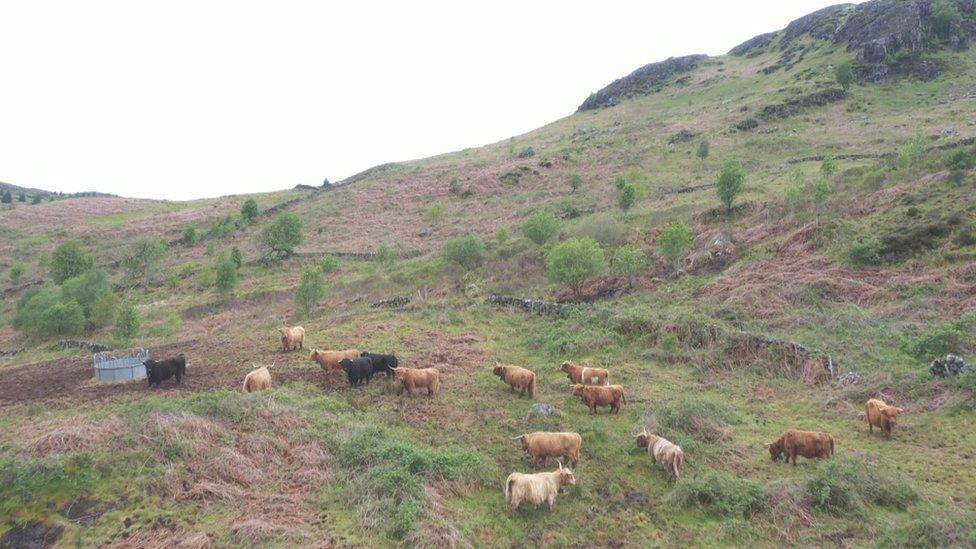App-controlled cows could help ancient Galloway woodland grow
- Published

The collars emit an audio warning to cattle when they approach a boundary
App-controlled cows are being used in south west Scotland in a bid to boost biodiversity.
The trial of virtual fence technology - which sees cattle fitted with GPS collars - is a first for Forestry and Land Scotland (FLS).
The collars emit an audible warning when the animals near the edges of their mapped-out grazing area.
If they ignore the alert they receive a "pulse" which is equal to that emitted by a standard electric fence.
The trial site in Dumfries and Galloway has been specially selected because it is next to the Glentrool Oakwoods site of special scientific interest (SSSI).
It is hoped the cattle can help reduce bracken growth in the areas they trample and thereby encourage the woodland to spread.

That, in turn, could provide a bigger area for special plants, birds and insects - some of which are rare - to thrive.
FLS environment forester Kim Kirkbride said the system - pioneered by Norwegian firm Nofence - was simple to use.
"On your phone, on your app, you create a boundary and then once it's activated that boundary is the fencing that the cattle remain within," she said.
"If they get near to that fencing, an audio will start to play and the closer they get, the more frequent that audio will sound.
"Then, if they get too close to that fence after a few audios have warned them, they will then receive what's known as a pulse and the pulse is the same as what an electric fence would be if a cow was to touch an electric fence."

A virtual fence helps keep the cows within certain boundaries
She said they quickly learned from the audio not to go any further and remain within the boundaries which had been set.
"We can have this virtual boundary so that we can then move the animals around the pasture and we can close off areas," she said.
"The app allows me to access it daily and it shows me the movements of the cattle at all times."
It also lets her know if cattle go near to a boundary, if they receive a pulse or warning and if they escape from the area.
Ms Kirkbride said the advantage of not having to put up fences at Glentrool was clear.

Environment forester Kim Kirkbride said there were a number of advantages to the system
"Obviously we have a lot of beautiful landscape up here, and the last thing you want is to have to erect fencing and to stop the cattle from being able to get out so it completely wipes that need whatsoever," she said.
She said there could also be ecological benefits.
"For this particular area that we are trialling at the moment it is to break down the bracken so that we can get natural seed dispersal from the adjacent SSSI, which is the Glentrool Oakwoods which is designated for its Atlantic Oakwoods," she said.
"Hopefully we can get some natural seed dispersal of this ancient woodland out on to the open ground adjacent.
"So the cattle are helping us to do this natural management for the trees to survive."
Visitors to the area can also scan a QR code and from that they will learn where the cattle are and know to keep away from them.
"This specific trial area that we've used, we don't have any public footpaths going through it," said Ms Kirkbride.
"Touch wood the cows have been out on the ground for three weeks now and we have not had any altercations."
She said that there was no welfare issue in using the collars.

If the project proves to be a success it could be extended elsewhere
"When the collars go on, it would be something going around their neck, but the studies have shown they become used to it very quickly," she said.
"It's literally maybe just a head shake and that's all they'll do and they become accustomed to it very quickly."
This is the first year of the trial and a drone flight was carried out before it started and another one will be carried out afterwards to see if it is successful in its goals.
If so, FLS could look to repeat it again next year and consider its use in other parts of the country.